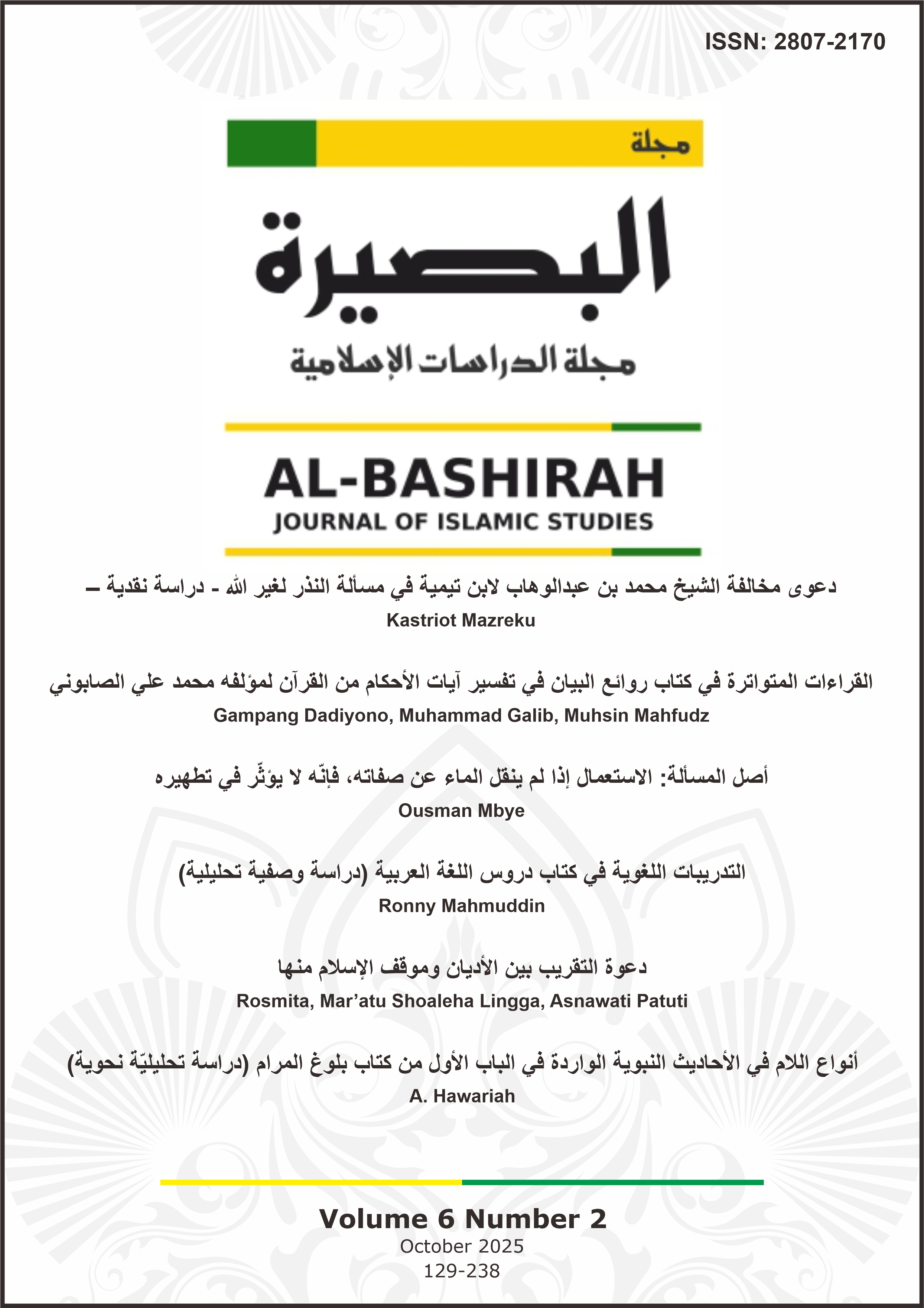القراءات المتواترة في كتاب روائع البيان في تفسير آيات الأحكام من القرآنلمؤلفه محمد علي الصابوني
The Mutawātir Readings in Rawā’i‘ Al-Bayān in The Exegesis of The Qur’anic Legal Verses By Muḥammad ‘Alī Al-Ṣābūnī
DOI:
https://doi.org/10.36701/bashirah.v6i2.2507Keywords:
Qirā’āt, Mutawātir, Rawā’i‘ al-Bayān, Muḥammad ‘Alī al-ṢābūnīAbstract
This study aims to examine the existence and influence of mutawātir readings (qirā’āt) on the determination of legal rulings in Rawā’i‘ al-Bayān fī Tafsīr Āyāt al-Aḥkām min al-Qur’ān authored by Muḥammad ‘Alī al-Ṣābūnī. The research focuses on five selected legal verses that contain qirā’āt variations, namely the words: nansa-hā, yuṭīqūnahu, yaṭhurna, qur’, and arjulakum. It addresses how these mutawātir readings contribute to the formulation of legal conclusions within al-Ṣābūnī’s exegesis. The study employs a qualitative approach, using the comparative exegesis method (al-tafsīr al-muqāran) and a thematic approach to legal verses containing mutawātir readings. The primary sources consist of two volumes of Rawā’i‘ al-Bayān, while the secondary sources include classical and contemporary works relevant to the sciences of qirā’āt and legal exegesis. Documentation and textual analysis methods were applied to uncover the structure of al-Ṣābūnī’s exegesis and the role of qirā’āt in his legal reasoning. The findings show that mutawātir readings play a significant role in enriching the semantic scope of Qur’anic terms and in shaping legal understanding, although they are not always the principal basis for legal preference (tarjīḥ). Al-Ṣābūnī tends to combine the method of exegesis by transmission (bi al-ma’thūr) and exegesis by opinion (bi al-ra’y), with strong reliance on juristic opinions and consideration of the objectives of Islamic law (maqāṣid al-sharī‘ah). In certain cases such as abrogation (naskh) and the waiting period (‘iddah) differences in readings had a direct impact on the legal conclusion. In other cases such as the rulings on ablution (wuḍū’) and menstruation mutawātir readings served more as a support for semantic breadth rather than as determinants for legal preference. The study concludes that understanding mutawātir readings is essential for the development of Qur’anic legal interpretation in the contemporary era, as these readings are a fundamental tool in constructing legal reasoning within tafsīr. Therefore, the employment of qirā’āt in exegesis as exemplified by al-Ṣābūnī constitutes a significant scholarly contribution to the methodology of deriving rulings from the Qur’an.
Downloads
References
Al-Ayubi, Sholehudin. “Metodologi Penafsiran Al-Qur’an.” Fikroh: Jurnal Pemikiran dan Pendidikan Islam 4, no. 2 (2011): 95–104.
Al-Jazari, Ibn, dan A KS. “al-Nashr fi al-Qira’at al-‘Ashr.” Beirut, Dar al-Kutub al-‘Ilmiyyah, 1998.
Al-Nasyar, Sirajuddin. Al Budur al Zahirah Fi al Qira’at al Asyr al Mutawatirah. Kuwait: Dar al-Nawadir, 2011.
al-Nawawī. al-Majmū: sharḥ al-Muhadhdhab. Dār al-Fikr, 1985.
Al-Qurtubi, Muhammad bin Ahmad. al-Jāmi’ li Ahkām al-Qur’ān. Kaherah: Maktabah al-Sofa, 2005.
al-Razi, Fajr al-Din. al-Tafsir al-Kabir. Dar Ihya’al-Turat al-Arabi, 1980.
Al-Ṣabuni, Muḥammd‘Alī. “Rawā’i al-Bayān: Tafsīr Āyāt al-Aḥkām min al-Qur’ān.” Damaskus: Maktabah al-Ghazālī, 1980.
Al-Salih, Subhi. Mabahith fi’ulum al-Quran. Dar al-’Ilm li al-Malayin, 1959.
Al-Ṭabarī, Ibn Jarīr. Jāmiʿ al-Bayān ʿan Ta’wīl Āy al-Qur’ān. Beirut: Muassasah al-Risālah. Kairo: Dār al-Tarbiyah wa al-Turāth, 1994.
al-Zarkashi, Badr al-Din Muhammad. Al-Burhan fi’ulum al-Qur’an. Dar al-Fikr, 1988.
Al-Zarqani, Muhammad Abdul Azim. “Manahil al-‘irfan.” Beirut: Dâar Al Fikr, Tt, 2001.
Daud, Zainora, dan Muhammad Ibrahim. “Kajian Persepsi Pelajar Terhadap Pengajaran Dan Pembelajaran Qiraat Di USIM.” Journal of Quran Sunnah Education & Special Needs 3, no. 2 (2019): 46–53. https://doi.org/10.33102/jqss.vol3no2.53.
Fathurrosyid, Fathurrosyid. “Tipologi Ideologi Resepsi Al Quran Di Kalangan Masyarakat Sumenep Madura.” El Harakah Jurnal Budaya Islam 17, no. 2 (2016): 218. https://doi.org/10.18860/el.v17i2.3049.
Haryono, Andy, dan Abdur Razzaq. “Analisis metode tafsir muhammad ash-shabuni dalam kitab rawâiu’al-bayân.” Jurnal Wardah 18, no. 1 (2017).
Hawasi, Ahmad. “Qira’at Mutawātir dalam Jāmi’al-Bayān fī Ta’wiīl Al-Qur’ān.” Al-Fanar: Jurnal Ilmu Al-Qur’an dan Tafsir 2, no. 2 (2019): 165–80.
Mustaqim, Abdul. Epistemologi tafsir kontemporer. Idea Press, 2020.
Mustofa, H. “Implikasi Keragaman Qira’at Al-Qur’an Terhadap Tafsir dan Istinbat Hukum.” Al-Bayan: Jurnal Studi Ilmu Al-Qur’an dan Tafsir 7, no. 1 (2022).
Sukardi. Metodologi Penelitian Pendidikan Kompetensi dan Prakteknya. 3 ed. Jakarta: PT. Bumi Aksara, 2005.
Taimiyyah, Ibn, dan Taqiuddīn Aḥmad bin‘Abd al-Ḥalīm. “Muqaddimah fī uṣūl al-tafsīr.” Kuwait: Dār al-Qur’ān al-Karīm, 1971.
Taufik, Akhmad. Metodologi Studi Islam: Suatu Tinjauan Perkembangan Islam Menuju Tradisi Islam Baru. 1 ed. Malang: Bayumedia Publishing, 2004.
Downloads
Published
Issue
Section
License
Copyright (c) 2025 Gampang Dadiyono, Muhammad Galib, Muhsin Mahfudz

This work is licensed under a Creative Commons Attribution-NonCommercial-ShareAlike 4.0 International License.



.jpg)









